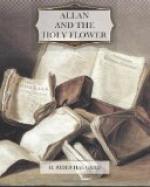“The white woman, the white woman and her daughter,” muttered Brother John.
“Yes,” reflected Stephen aloud. “One is justified in doing anything to get two white women out of this hell, if they exist. So one may as well have the orchid also, for they’d be lonely without it, poor things, wouldn’t they? Glad I thought of that, it’s soothing to the conscience.”
“I hope you’ll find it so when we are all on that iron grid which I noticed is wide enough for three,” I remarked sarcastically. “Now be quiet, I want to go to sleep.”
I am sorry to have to add that for the most of that night Want remained my master. But if I couldn’t sleep, I could, or rather was obliged to, think, and I thought very hard indeed.
First I reflected on the Pongo and their gods. What were these and why did they worship them? Soon I gave it up, remembering that the problem was one which applied equally to dozens of the dark religions of this vast African continent, to which none could give an answer, and least of all their votaries. That answer indeed must be sought in the horrible fears of the unenlightened human heart, which sees death and terror and evil around it everywhere and, in this grotesque form or in that, personifies them in gods, or rather in devils who must be propitiated. For always the fetish or the beast, or whatever it may be, is not the real object of worship. It is only the thing or creature which is inhabited by the spirit of the god or devil, the temple, as it were, that furnishes it with a home, which temple is therefore holy. And these spirits are diverse, representing sundry attributes or qualities.
Thus the great ape might be Satan, a prince of evil and blood. The Holy Flower might symbolise fertility and the growth of the food of man from the bosom of the earth. The Mother of the Flower might represent mercy and goodness, for which reason it was necessary that she should be white in colour, and dwell, not in the shadowed forest, but on a soaring mountain, a figure of light, in short, as opposed to darkness. Or she might be a kind of African Ceres, a goddess of the corn and harvest which were symbolised in the beauteous bloom she tended. Who could tell? Not I, either then or afterwards, for I never found out.
As for the Pongo themselves, their case was obvious. They were a dying tribe, the last descendants of some higher race, grown barren from intermarriage. Probably, too, they were at first only cannibals occasionally and from religious reasons. Then in some time of dearth they became very religious in that respect, and the habit overpowered them. Among cannibals, at any rate in Africa, as I knew, this dreadful food is much preferred to any other meat. I had not the slightest doubt that although the Kalubi himself had brought us here in the wild hope that we might save him from a terrible death at the hands of the Beelzebub he served, Komba and the councillors, inspired thereto by the prophet called Motombo, designed that we should be murdered and eaten as an offering to the gods. How we were to escape this fate, being unarmed, I could not imagine, unless some special protection were vouchsafed to us. Meanwhile, we must go on to the end, whatever it might be.




